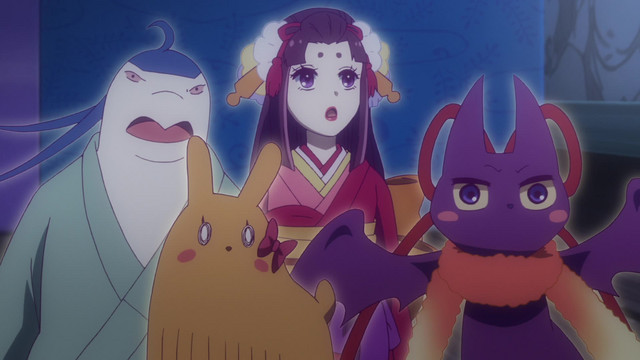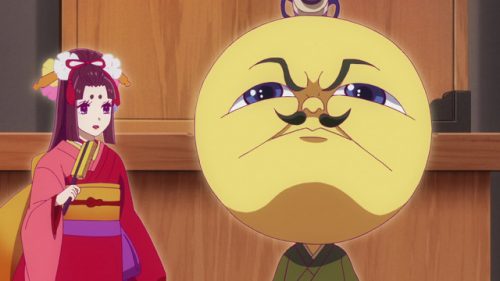
Have you ever had an inanimate object that you loved? A toy, teapot, or hair tie? If you truly love that object it may, after several hundred years, turn into a spirit. The west would say the object, like a doll, is haunted; but in the case of a tsukumogami the spirit isn’t necessarily malevolent. You can think of becoming a tsukumogami as being granted a reward by the universe for being cherished. This story takes place in the Edo period in Fukagawa ward. Edo-era Tokyo wasn’t the easiest place to live and was occasionally ravaged by fires and floods. The residents would turn to rental shops for items that were either destroyed by the disasters or that they wouldn’t have to take with them if they fled. You could find everyday items like pots and pans to expensive items like incense burners you’d rent for an occasion.
The story revolves around Okou and her younger brother Seiji. The siblings run a rental shop called Izumoya. The siblings also have several tsukumogami as part of their inventory and occasionally lend these spirits to unknowing customers. Okou and Seiji both can see and talk to their spirit friends and love them dearly. We find the siblings often place these items in the hands of people as a way of observing them or finding the answer to a mystery. We now take a look at the Top 8 Mystery Solving Characters in Tsukumogami Kashimasu.
8. Usagi (Comb)
Usagi is a wooden hair comb decorated with the painting of a rabbit (as her name suggests). She is also very energetic and prone to childish behavior. She credits it to often being part of the comb collections of many young girls over her lifetime. Usagi is often nostalgic for being used by mothers to brush out their daughters’ hair. She is the brightest of the bunch but she often serves as a sounding board for the other tsukumogami as they try to help solve the mysteries put before them. She has one moment when she really shines. Usagi provides insight as to why one of their customers and her mother aren’t getting along and is able to help them understand each other.
7. Heizo
During the Edo era the Samurai that used to fight foreign invaders and each other became the country’s police force because of the relative peace. The samurai were aided by non-samurai, some of which were okappiki civilians, often former criminals, who worked as informers and spies. Seiji’s friend Heizo is one of them. He knows a lot of what goes on in the town and becomes a big help when Seiji is asked to help solve the mystery of the chivalrous bandit who had been making headlines in the local paper. Heizo is able to provide insight for Seiji on what might be motivating the bandit and how he might be getting away with it. He isn’t exactly essential in the solving of the mystery but his unique way of looking at things probably made a difference in bringing the story to a peaceful conclusion.
6.Tsukuyomi (Wall Scroll)

Tsukuyomi is a wall scroll that has a picture of a full moon on it. A wall scroll was considered a thing of culture during the Edo period. Japan was at peace between 1603 and 1868, allowing the arts to flourish. The kakejiku or wall scrolls also became popular among the public and would be hung for special occasions like tea ceremonies and banquets. Tsukuyomi is a little long-winded and often goes on at length espousing sayings he learned from hanging in the presence of many cultured men. More often than not he stumbles into the answer the others are looking for, giving him a spot on the list.
5. Okou Obeni

Okou is Seiji’s adopted older sister. She is also considered quite the beauty for a shopkeeper. Okou is the reason that Seiji got the reputation as a solver of mysteries by egging him on to solve the problems people bring to him. She is often the adult in the room since her brother seems to be unreliable in everything else except being a part-time gumshoe. She is the brains of the operation and runs the day-to-day business of the store. She, however, isn’t the one to make the creative leaps in deduction to put the pieces together. Okou simply provides the support and encouragement for her brother to investigate the mysteries in Edo.
4.Ohime (Doll)
Ohiome is a doll that is part of the lending inventory of lending shop. She is also a tsukumogami. She is often a bit excited, especially when it comes to the fun and frivolous things that young girls think about like love, adventure, and romance. She gets caught up in the idea of the chivalrous bandit as a romantic story. Ohime is especially susceptible to the story since she was once stolen from a man who didn’t admire her by a man who revered her beauty. She helps solve the mystery of the bandit by letting herself get stolen from the shop. She is taken to a shrine and after being left there she pretends to be a god and speaks to the bandit. She may not have been able to see the face of the bandit but she does get him to reveal his motive. Her willingness to be the bait, even though she could have gone missing from the shop forever, is the reason she is number four on this list.
3. Goi (Pipe)
Goi is a Japanese pipe called a kiseru and, of course, a tsukumogami. Goi spirit looks like a blue bird who is smoking a kiseru. The kiseru of the Edo typically has a mouthpiece and bowl made from metal, with a tubular shaft of wood or bamboo in between. The extremely long kiseru could be carried as weapons, especially by the gangsters of the time. Kiseru would often have been engraved with elaborate details by skilled artisans and were a status symbol for their owners. Goi is definitely the thinker of the group of tsukumogami. He is also instrumental in convincing the other spirits at the Izumoya to participate in a ruse that convinces Okou to manipulate a romantic situation between one of their customers and a hostess at a sweet shop that resulted in a confession of love.
2. Notetsu

Notestu is a bat-shaped Netsuke. The term netsuke is from the combination of the two Japanese characters ne+tsuke or “root” and “to attach,” referring to the way the item was used to attach things to one's belt. He is very distrustful of humans, believing that as soon as a human decides they don’t need you anymore they get rid of you. He spreads his wings early in the show and is helpful in solving the first mystery: the case of a missing mouse netsuke. Right off the bat we’ll admit he has an advantage over the other tsukumogami. Notetsu can fly. In his spirit form he is a purplish bat and has the ability to fly around at will. He is by far Seiji’s best informant. Notestsu is integral to solving several of the cases presented to Seiji, giving him the obvious position of number two on this list.
1. Seiji
Seiji is Okou’s younger brother and co-owner of the lending shop they run together. Okou thinks he’s a little immature and unreliable. She does trust him, but thinks he needs a little supervision. On more than one occasion he’d been chastised by his sister for not treating the inventory with more care. She often sends him out to make deliveries while she minds the shop. He is also the one that seems to have a creative mind and it’s the kind of creativity that can put together missing pieces and information to solve a mystery. Seiji notices things and does a lot of leg work, talking to people from all classes of Edo society to gradually put together the puzzle pieces of the mysteries presented to him. He is easily the best investigator with or without supernatural help.
Final Thoughts
We were surprised as the series went on that they didn’t fall into many of the tropes they danced around. We get the idea several times that step-siblings Obeni and Seiji have some not-so-sibling feelings for each other. We are even given an explanation of how they became siblings as “adoption” of random orphaned children after a disaster was common. Yet, the story doesn’t push that storyline too much. We also find that in spite of its slice-of-life/mystery nature, the story has an ongoing subplot about something named Suou (mentioned in the first episode) that turns into a nice payoff for your time and attention. The final reason we enjoyed this program is Seiji pounding the beat of Edo asking questions and finding answers for people who ask for his help, solving their mysteries making him the Holmes of Old Edo.
Recommended Post



